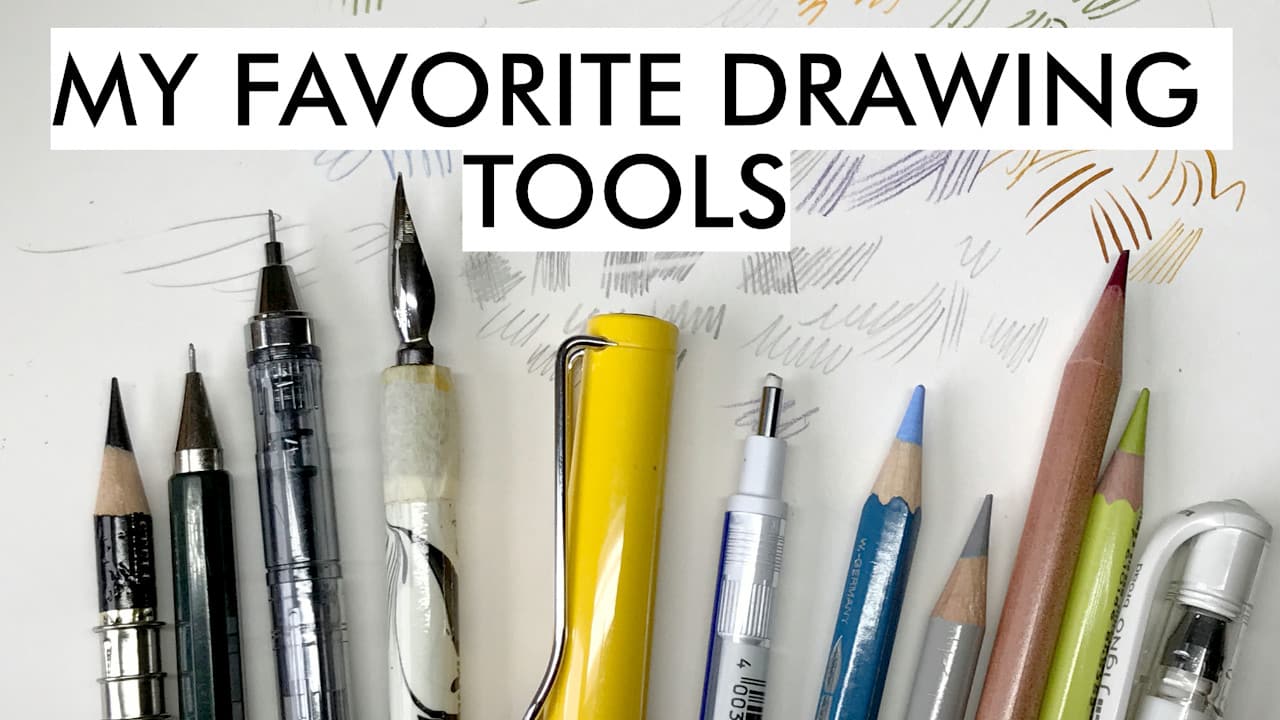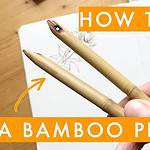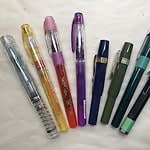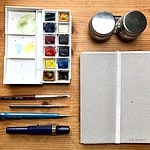I think it is always interesting to see which tools other artists use, and today I want to take a closer look at my favorite drawing tools. I don’t really switch my drawing gear that often once I’ve found a pen that I like.
Here’s a video version of this post:
My favorite drawing tools right now (video)
Pencils & colored pencils
For field sketching and in the studio, I mostly use a simple mechanical pencil with HB or 2B lead. Not everyone likes mechanical pencils, but I like the convenience of always having a sharp, fine point without a pencil sharpener. I also use regular pencils, but at the moment I prefer the mechanical ones.
I don’t really like anything softer than 2B for sketchbook work, because that tends to smear the graphite all over the page. HB pencil sketches on their own can sometimes look a bit anemic – you can’t really push dark values with them, so I often add watercolor or colored pencil on top.
Colored pencils on their own produce really nice strokes, too – I like to have a few neutral dark colors (warm greys, dark violets) around, and you can make quite expressive marks with them. They’re usually wax- or oil-based and don’t smudge that easily. A light color can also serve for initial rough sketches that will be painted over later.
I will cover colored pencils in detail in a future post – they’re a really interesting addition to any sketching kit, and I love combining them with watercolor or ink washes.
Fountain pen
I love my Lamy fountain pens, and combined with waterproof drawing ink for fountain pens this is a great combination. I use Sketch Ink by Rohrer & Klingner – it’s waterproof and can be painted over. You can either combine ink lines with watercolor or let the drawing stand on its own, I quite like the look of pure ink drawings with variable lines. You can produce wonderful modulating lines with a fountain pen – something that I always find lacking from drawings with a technical pen or fineliner. Try turning the pen nib around for very fine lines. I carry some inevitable fineliners around with me – but I almost never use them. I also like that you can refill fountain pens infinite times so there’s no throwaway plastic from empty pens. (I have refilled fineliners in the past, but you’ll have to apply brute force and the results often involve inky fingers). I keep multiple fountain pens around filled with different ink colors, so that I can switch and combine colors in my sketchbook, an effect I really like.
Dip nib & ink
When I’m at my desk, I sometimes like to use dip nib pens instead of the fountain pen. Their advantage is that you can use any ink without having to think about clogging your pen, and the variety for nibs is huge. I still have a ton of flexible pointed nibs from my calligraphy days, but for sketching I enjoy the slightly more rigid drawing nibs. You can make wonderful expressive lines with them, much more so than with a fountain pen. They are also one of the most sturdy and sustainable drawing tool. The holders will last for ages, the steel nibs need to be replaced from time to time.
Erasers, gel pens, miscellaneous tools
As erasers, I like to have a standard vinyl eraser around, as well as a kneaded eraser for more delicate lifting. A fine-point eraser can work as a drawing tool itself – you can produce fine highlights with it. I have a gel pen in my field kit for adding quick highlights. Gel pens are always a compromise – they never produce really strong white marks, but they can be great for adding small light marks like the white in an animal’s eye or delicate white patterns on leaves or feathers. An alternative can be very soft white colored pencils or white gouache, or leaving the paper white if that works in your sketch. I also like to have a pencil extender on hand, which will allow me to use very short pencil stumps till the end.
These are essentially all the drawing tools I use – not very fancy, but they are adapted to my needs. From all of these, I definitely like the ink-based tools the best in terms of line quality, and I probably use my (mechanical) pencils the most.
What’s in your drawing toolbox and what drawing tool do you use the most?






Of course I have so many pencils and such I could open my own stationery shop. However, I use about two! Unlike you I have a heavy metal Kwaeco SketchUp pencil with a 6B lead. Great shader, but you have to use a tissue or piece of paper under my hand to prevent smudging. I have used ink but prefer the kind of textures a pencil gives me. Like you, I prefer mechanical pencils and use a Faber TK9400 with a 6B lead for line work. That and a kneaded eraser is about it. I find I do at least the same amount of ‘drawing’ with the eraser as I do with the pencils. You can see some of the results on my Instagram page @powis55 . Also take a look at Albrecht Rissler’s blog. He’s a great draughtsman. Love your stuff!
Yout approach sounds very interesting, thanks for sharing David! I definitely do a lot of drawing with the eraser, too. Albert Rissler is a great recommendation (I know one of his books) and many thanks for the insight into your toolbox. 🙂
This was great and really shows that less is more….. I have way to many bits and bobs collected over the years but tend to use just a limited selection……..it is always interesting to see what others have in their tool box. Love your work and skill share classes.
Thank you Janey! It’s really been the same for me, making this video made me realize that I really use the same tools over and over. 🙂
Good post, Julia. I have recently fallen for pointed pens and am trying out different nibs. I like the Leonardt 256 for writing…would love to hear your preferences!
The 256 looks like a great nib for writing! I mostly use stiffer drawing nibs that are just as flexible as (or a bit more than) my fountain pen. There’s a drawing nib 6H by Leonardt that I really like, and a Japanese nib called Saji. For more flexible lines, the Nikko G nibs are great.
Thank you, I’ll check them out!